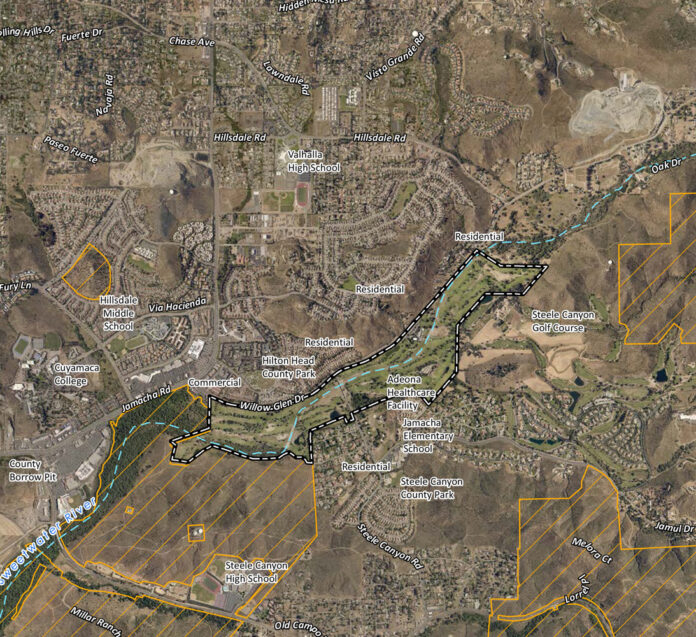The Valle De Oro Community Planning Group unanimously voted to adopt a letter to the County Board of Supervisors opposing the proposed Cottonwood Sand Mining Project in its neighborhood at its Feb. 1 meeting, with the emphasis that it is incompatible with its community plan. More than 150 participants attended the virtual meeting.
In drafting the conclusion to the letter, the Planning Group approved the following language of the draft letter.
“The VDO CPG opposes development that is incompatible with our community plan, established land uses, and existing quality of life. We oppose projects that carry high potential to reduce quality of life, increase health risks, and reduce economic stability of our properties. We maintain that the community can only thrive if development and land uses within the Planning Area are compatible with surrounding land uses and consistent with the Community Plan. The Project contravenes the Community Plan. Accordingly, the VDO Community Plan should be adequately and appropriately considered in the environmental review process for all proposed new development that will impact the community, such as the Project.”
VOD CPG member and a member of the Cottonwood Sand Mining Subcommittee, Allison Henderson reminded people that the project is only is Stage 3 of the five phase permitting process, which is public comment on the Draft Environmental Impact Report of the Project, and that the Project was first proposed to the CPG in 2019.
The Cottonwood Sand Mining Project proposes the conversion of the existing Cottonwood Golf Club golf courses to a 10-year sand mining operation with an additional two-year reclamation period.
About 214.4 acres of the approximately 280-acre site are proposed for extractive use which would occur in a total of four phases. Cottonwood Golf Club, located on Willow Glen Drive within Rancho San Diego in unincorporated El Cajon, was purchased by Michael Schlesinger in 2018 through his company, New West Investment Group, Inc., located in El Cajon.
Helix Environmental Planning Vanessa Toscano, project manager for the EIR, added additional clarification on the Project’s materials processing, water use, reclamation process, and project phasing. She said the material to be excavated would primarily consist of sand and smaller gravel consistent with a flood plain with no crushing or blasting during excavation or processing. Project water would be received from existing wells, but that water use would be decreased by an estimated 80% than used by the Cottonwood Golf Course. Water would be used for materials processing, but that 87% of needed water for washing operations would be continuously reused and recycled. Temporary irrigation would be installed for revegetation after mining operations.
Toscano said reclamation would begin immediately after each mining phase. She said that each phase of mining is broken down into three to four substages for active mining of 15 to 30 acres, which would be mined over one year each. She said that with the current plan, no more than 30 acres, or 11% of the 280-acre project site would be in active mining at any given time.
“The remainder of the site would either remain untouched, being reclaimed, or already revegetated with native scrub or riparian vegetation or erosion control seed mix,” she said. “Project phasing was intentionally reduced to 15 to 30 acres increments as subphases to reduce the adverse environmental effects of the project, particularly visual impacts.”
Toscano said the project has an imposed limit of 88 trucks that may enter the site each day, limiting the number of trucks on the road and that trucking activity would be from 9 a.m. – 3:30 p.m., outside of peak traffic hours. She said it would reduce regional vehicle miles traveled, since it would supply a local supply of sand and reducing the need for imported sand.
Henderson said the committee was tasked by the chair to draft a letter of recommendation on behalf of the entire VOD CPG.
“There are multiple considerations with respect to the rational of this project, to the adequacy and the completeness of the DIER, and we discussed a multitude of issues and concerns,” she said. “Our draft letter is a starting point, but it is extensive. As a subcommittee we viewed that the DIER was flawed and incomplete, and not in compliance.”
Gene Mulchy said he was surprised to see how inadequate the DIER is.
“It seems to me, to expedite a redraft of the DIER if not to consider the project as being totally unworthy of consideration,” he said.
Immediately adjacent to the south of the proposed project, Adeona Healthcare Facility representative Vince Kattoula said that it is formally opposing the Project for several land use and environmental reasons.
“Should the County proceed in approving this project, our group is prepared to explore all options,” he said. “Including a potential referendum, which would ultimately have the voters decide if a sand mine sandwiched between homes, an elementary school, and a healthcare facility, is an appropriate land use decision.”
The project requires a major use permit and reclamation plan.
DEIR documents can be reviewed on the County’s website at www.sandiegocounty.gov/pds/ceqa/MUP-18-023.html. DEIR documents can also be reviewed at the Rancho San Diego Library located at 11555 Via Rancho San Diego, El Cajon, and the Casa de Oro Library, at 9805 Campo Road, #180, Spring Valley. The public review period has been extended to end on Feb. 28. Comments on the DEIR must be received by the County no later than Feb. 28, 2022, at 4 p.m. Comments on the DEIR must be sent to Robert Hingtgen, Planning & Development Services, 5510 Overland Avenue, Suite 310, San Diego, CA 92123 or emailed to Robert.Hingtgen@sdcounty.ca.gov.
To read the Valle De Oro Community Plan, visit https://www.sandiegocounty.gov/content/dam/sdc/pds/docs/CP/Valle_de_Oro_CP2.pdf.














